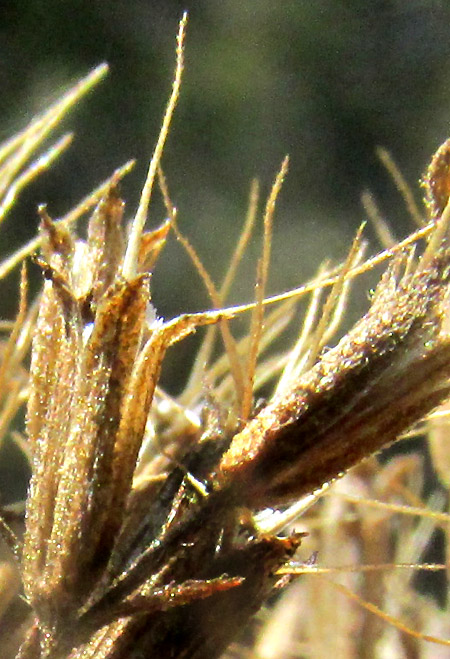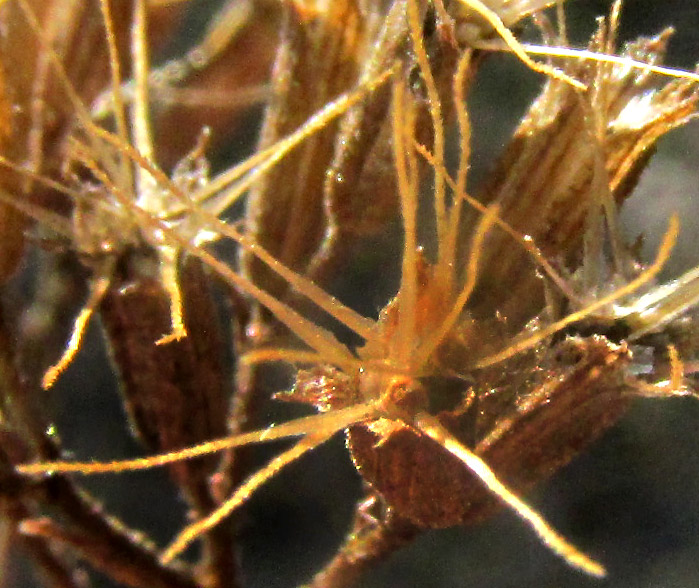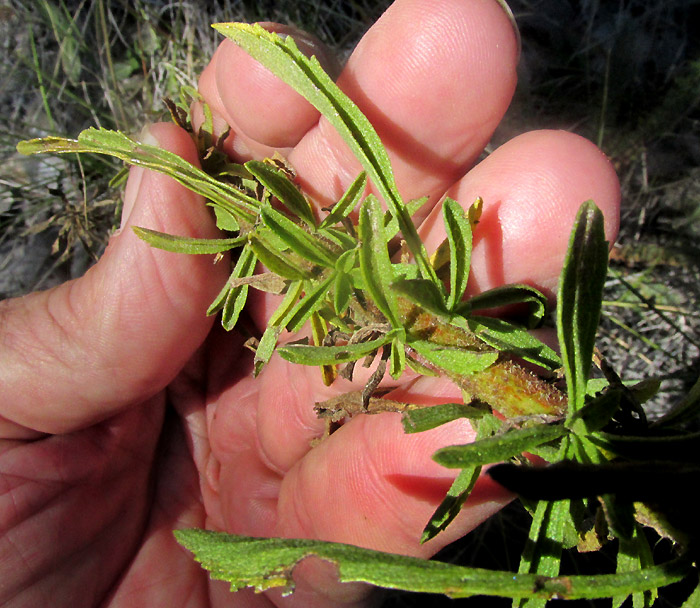Excerpts from Jim Conrad's
Naturalist Newsletter
Entry dated November 7, 2023, from notes taken near Cascadas de La Piedad waterfall 3kms NW of the community of San Pablo, municipality of Almeaco de Bonfil; bedrock of thick layers of compacted volcanic ash, or tuff; N20.1024°, W100.0019°, elevation 2360 meters (7750ft); extreme southern Querétaro state, MÉXICO
STEVIA EUPATORIA

In a grassy open spot on a slope mostly forested with oaks, the above plant bore no flowers, but its prolific, light brown fruiting head glowing in a narrow ray of sunlight was so spectacular that I hoped it could be identified. The big head was a classic corymb-type inflorescence, corymbs being flower clusters with lower stalks proportionally longer so that the flowers grow upward forming a flat or somewhat convex head, plus the flowers' pedicels do not all arise from the same spot atop the stem -- in which case it would be an umbel.

The corymb consisted of many small heads which themselves comprised several florets held within a bowl-like structure, the involucre, formed by several scale-like bracts, or phyllaries. This unique arrangement meant that our plant belonged to the largest of all plant families, the Composite/Aster/Sunflower Family, the Asteraceae.
For further identification it was important to notice that the phyllaries, five in number, were all the same length and stood side by side. Involucres of the vast majority of Aster Family species consist of overlapping phyllaries, often arranged in a spiraling fashion. Also important was that the phyllaries, pedicels and stems bore short, close-lying hairs among which appeared many tiny, glistening points of reflected light, which apparently were glands.

Each capitulum head had contained only a few flowers, about five, and now some of the one-seeded, cypsela-type fruits already had been dispersed. The above photo looks down onto the head of a cypsela, from which three needle-like bristles radiate upwards and outwards. The bristles as a unit constitute the pappus, which in many species -- when present at all -- are hairlike, scaly, more spinelike, crown-like, or otherwise. Inside the same capitulum it looked like three other cypsela remain, their pappus bristles crisscrossing with one another, making it hard to focus on just the three bristles atop the featured cypsela.

Stem leaves were slender with only a few low teeth occurring toward the blades' tips. The blades gradually narrowed to their bases, not developing petioles. Both stems and leaves showed more tiny glistens, the presumable glands.
The technical identification of unrecognized flowering plants overwhelmingly relies on flower features. Despite recognizing our plant as a member of the vast Aster Family, I still needed to know such basic facts as whether the capitula contained both disc and ray flowers or only one type, and if so, which type, and whether scale-like paleae or bristles had grown among the florets inside the head. Based on experience and hunches, I guessed that our plant's flowering heads had contained only cylindrical disc florets, and that capitula with so few florets probably had no paleae separating the florets. In the end, those guesses turned out right.
In our part of upland central Mexico, if you have an Aster Family member with the features guessed at above, plus the phyllaries are of equal height, number about five and bear glands, and the pappus consists of three stiff bristles, then you have the big genus Stevia Currently Kew's Plants of the World Online database accepts 269 Stevia species. The 2018 study by Erika Villagómez-Flores and others entitled "The genus Stevia (Eupatorieae, Asteraceae) in the state of Morelos, Mexico," tells us that in Mexico Stevia is the third-most diverse genus of the enormous Aster Family, represented by 116 species, of which 107 are endemic.
Often Stevia species are called candyleafs, for the leaves of some species have a sweet taste. In fact, Stevia is the genus providing the famous sugar substitute sold commercially as Stevia, though the plant grown for that purpose is Stevia rebaudiana, native to Brazil and Paraguay, not Mexico. Earlier we've documented a flowering Stevia, Stevia pilosa. Our present Stevia, with its different kinds of hairs and lack of glands on the phyllaries, didn't appear to be that one.
In upland central Mexico, maybe about 21 Stevia species have been documented. Among those 21, if your plant's phyllaries bear glands, its leaves arise one at each node, not opposite one another (maybe with sprouts of small leaves in the leaf axils), and the inflorescence is a dense, stiffly arranged corymb, then you have STEVIA EUPATORIA, with no English name. Those glands are the critical detail to notice.
Stevia eupatoria is endemic just to oak and pine forests throughout most of Mexico's highlands, and seems to be most documented in our general central area. Sometimes it's invasive in other countries. In JV Lovett's 1986 study "Allelopathy: the Australian experience," Stevia eupatoria is reported, in Australia, as producing allelopathic effects when it's a weed in clover fields, amid Trifolium species. Allelopathy is a negative or positive, chemical-caused effect of one plant species on another.
In the 2021 study of Jimena Borgo and others entitled "Stevia Genus: Phytochemistry and Biological Activities Update," our Stevia eupatoria is reported as used in Cuban traditional medicine against malaria, to relieve stomachache, to lower blood sugar, as an analgesic and against inflammation in general, and against hypertension.
Clinical studies have confirmed that Stevia eupatoria is effective in certain treatments. E. Martínez-Rojo and others in their 2020 study "Stevia eupatoria and Stevia pilosa extracts inhibit the proliferation and migration of prostate cancer cells," found that root extracts of Stevia eupatoria significantly reduced the migration and viability of cancer cells.
I find no specific mention of our Stevia eupatoria being used as a sweetener, though an anonymously produced, very ad-heavy page at India's agrifarming.in website entitled "Introduction to Stevia Cultivation," mentions Stevia eupatoria as one of only six Stevia species being used as sweeteners.